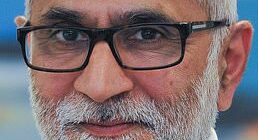One February night in a London hospital, my perception of time shrunk to the span of a moment. Around 24 hours after my wife went into labour, we were rushed into emergency surgery. Our baby had acquired an infection. As I held my wife’s hand in the sterile silence of the operating theatre, it felt like nothing else in the world existed. Our recent past of slow, stable expectation faded away and the future became impossible to see with any fidelity – all that was left was now.
We were lucky; the threat receded, and after five nights of recovery and antibiotics, we stepped out of the timeless maternity ward and back into the world, carrying our daughter, Grace. Gradually, our future as a new family settled into view.
I am fortunate to have encountered such emergencies only rarely in my life – encounters with shock, fear or sudden loss – but for each, I can recall how time fell out of joint. Crisis tends to trap you in the present.
Over the past few years, I’ve been researching and writing a book called The Long View, about why our sense of time is malleable – how it can be foreshortened without us realising and how to lengthen our perspectives. Unlike the vast majority of other animals, we have a remarkable ability to manipulate time in our minds. Scientists call it “mental time travel”: as you read these words, you can transport your perspective into the past and stitch together those memories into a tapestry of possible futures.
However, that does not mean our timeviews cannot be coloured, swayed or even diminished. Every day, we are exposed to a barrage of temporal stresses: shortsighted targets, salient distractions and near-term temptations. When these combine with the psychological habits we inherited from our ancestors, a longer perspective can recede from view.
One temporal stress that we now face daily is the sense that we live in a period of concatenating crises: financial crisis, pandemic crisis, climate crisis, Ukraine crisis, cost-of-living crisis – each one blending into another. People talk of a polycrisis, a cluster of related global risks and their effects, and of a permacrisis, the Collins Dictionary’s 2022 word of the year, defined as “an extended period of instability and insecurity”.
Is it true? Certainly it is for people personally affected by conflict, poverty or loss. But for those who live in relative comfort – myself included – it’s less clear. I know that, for my part, the media I consume influences how I feel about myself and the world, whereas when my great-grandparents faced upheaval, they did not have to live in a 21st-century news environment with 24-hour feeds and daily doomscrolling.
Doomscrolling is not good for mental wellbeing and health. In one study, people asked to watch negative news bulletins were more likely to feel anxious and sad afterwards, and to catastrophise a personal worry that had nothing to do with the content. But more subtly, a daily diet of bad news could be influencing our timeviews. Immersing oneself in negative news risks the onset of doomism, a form of apathy where the future stops being plural – shrinking to a singular path or even seeming to end altogether – without us realising. A diet of continual outrage and shock can create skewed mental models of the past, present and future. People’s judgments become based on what’s most readily available and prominent in memory – a psychological effect called the “availability heuristic”. The mind tends to paint possible futures using experiences that are most accessible.
We’re also affected by whatever the loudest, most urgent distractions of the moment are, distractions in the present that come to dominate decisions. When people look ahead, the quieter information – slower changes that don’t get picked up by the news – tend to be ignored. It’s like what happens when you see a car crash, as the influential psychologists Amos Tversky and Daniel Kahneman once put it. “It is a common experience that the subjective probability of traffic accidents rises temporarily when one sees a car overturned by the side of the road.” The irony is that people tend to underestimate their risk of a vehicle crash, and overestimate their risk of, say, terrorism, when it appears on the news. After 9/11, many people shunned flying to travel by car instead, which researchers estimate caused 1,200 additional deaths in the US.
READ RELATED: 20 Gifts for Someone Going Through Chemo in 2023
As we navigate the time-shortening pressures of the modern world, it’s worth noting that our minds did not evolve to take a long view. Our mental time machine we inherited from our ancestors changed the course of human evolution, but it came with flaws. One example is the way the mind tends to equate time with space. This is reflected in culture. Consider the pairing in the opening line of Star Wars: “A long time ago in a galaxy far, far away…”
This tendency to entwine physical dimensions with temporal distance – called construal level theory – means that, in practice, people tend to place greater emotional weight on events that are visible, clearly in view, while feeling relatively indifferent to events “far” from now. The upshot is that events presented within the daily or hourly cadence of news gain disproportionate attention. Take the climate. Because many of its impacts won’t be seen for years and decades, it’s hard for some to register that the world is heating up until something serious happens, like weird weather, a flood or wildfire.
So, how might we cultivate a healthier timeview? We can’t step out of the present altogether as doing so runs the risk of becoming detached from the injustices and suffering of today. However, it is possible to seek out the long news – of the decade or century, not just yesterday, today and tomorrow. Personally, I have tried to increase the time I spend reading books or longer-form journalism, for example, and cutting back on Twitter (I fail often, but at least I’m failing consciously).
There’s also a growing body of psychological research showing techniques for achieving a longer view. One of the most promising is perspective-taking, where people are asked to step into the shoes of past or future generations to imagine their point of view. Researchers have found this is more effective than showing people data or abstract information, encouraging cross-generational empathy that can reduce psychological distance on issues such as future climate change.
For me, this begins with my daughter, Grace, imagining her path to the next century. She will be 86 years old in 2100. I find it remarkable to consider that there are tens of millions of citizens of the next century already living among us – and when I do so, my sense of time and possibility opens up a little more.
Discovering a longer view is not easy. When I look back at my own attempts over the past decade, I can see just how much my time perspective has fluctuated – and evolved. Indeed, halfway through drafting this article, I lost my sense of time entirely. In April, I was hospitalised in a mountain bike crash that left me with temporary amnesia, and no firm footing on my path from yesterday to tomorrow. My wife tells me I’d “wake up” every so often, shocked to learn about the accident, before responding with the same four words: “So, fill me in…” I was trapped in a loop, stuck in my own personal “now”.
Looking back today, with my mental time machine restored, I am reminded how lucky I am to experience time in the way I do. The ability to project my mind across the long-term past and future certainly has its downsides – it allows me to worry, to fear what’s to come, and even to contemplate my own mortality – but it is also a gift. It allows me to see how far our imperfect species has come, and the clarity to see the possible paths ahead – a plural future, rather than a singular one.
What I have learned is that the long view is about much more than escaping the traps of the present. Sometimes, it is a perspective that allows one to transcend the stresses of the moment. Other times, it offers guidance in periods of uncertainty. Often, it provides principles for understanding the world. But most of all, it is a way of seeing what matters most within the here and now. The long view, I believe, can make the present more meaningful. So, while it may well be true that we live in a period of crises, if we are to navigate our way through 2023 and beyond, it begins by changing the way we see time.
The Long View: Why We Need To Transform How the World Sees Time by Richard Fisher is published by Wildfire at £16.99. To buy it for £14.95, go to guardianbookshop.com




